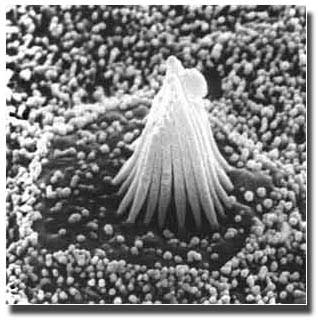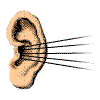![]()
Humming Along
Studies offer feedback on how ear's amplifier works

Courtesy Jim Hudspeth/ Rockefeller University
Hairs protruding from the top of this cellóa hair cell in the inner earómove in response to incoming sound. The movement sends electrical signals to the brain.
July 3, 2000
By Diana Steele / Special Contributor to The Dallas Morning News
In a quiet room you can hear the sound of a pin drop, or maybe the sound of another person's ear.The human ear's remarkable sensitivity - and its strange ability to emit sounds of its own - may be due to the same thing, a biological amplifier. Now new research is helping scientists understand more about how this amplifier works, and may eventually help them figure out how to fix it when it goes wrong.
Researchers in mathematics and neurophysiology at Rockefeller University in New York teamed up to provide a mathematical explanation for the ear's sensitivity, sound emission and distortion of incoming sounds. They published their findings in a recent issue of the journal Physical Review Letters.
Other research in France and the United States may
lead to a better understanding of the physiological basis of the ear's
amplifier, and could provide a window for understanding some forms of progressive
and congenital deafness. Two teams of researchers published papers recently
in the Proceedings of the National Academy
of Sciences and Nature.

Eighty-five percent of normal human ears spontaneously produce their own sounds.
The ear is remarkably sensitive to low levels of sound. More than 50 years ago, researchers realized that the ear could not have the sensitivity it does, nor be so exquisitely tuned to particular frequencies, without a biological amplifier of some sort. This is analogous to the amplifier in a public address system, which takes incoming sounds and uses electronics to make them louder. But the nature of the biological amplifier has been somewhat of a mystery. In addition to its sensitivity, the ear has some bizarre properties. In a quiet room, ears can actually produce their own sounds.
"Eighty-five percent of normal human ears can produce constant pure tones of sound in a quiet environment," says Rockefeller University hearing researcher Jim Hudspeth. "The loudest sounds, amazingly enough, are loud enough that they can actually be heard at a distance."
Dr. Hudspeth related a story of a dog whose ears made such loud noises that the owner complained about them. The dog's ears rang at a noise level equivalent to a person talking to a companion across a dinner table. In fact, a portion of what people call ringing in the ears, or tinnitus, can be attributed to this phenomenon, he said.
Another bizarre phenomenon is hearing tones not present in the original sound. In the 18th century, Italian composer and violinist Giuseppe Tartini noted that "if you played two pure tones on a violin," Dr. Hudspeth said, "you could hear, in addition to those tones, a whole panoply of other tones that weren't harmonically related." Dr. Hudspeth said some musical composers have taken advantage of this phenomenon, composing pieces in which no instrument actually plays the melody. Instead, the instruments play combinations of tones that together cause the ear to synthesize the melody.
He says that in a quiet room, the ear's amplifier is turned all the way up so that even the softest noise is amplified. At a loud rock concert, with plenty of electronically amplified sound, the ear's own amplifiers are turned off. During ordinary conversation the dial is set somewhere in between. But just like a sound technician adjusting the volume of an electronic amplifier to the highest level, sometimes feedback squeals out of the speakers. Dr. Hudspeth says that's how the ear generates tones in a quiet environment -- its amplifier may be set a bit too high.
As for why the ear hears tones that aren't really there, the mathematics boil down to the fact that the amplifier isn't linear, he says. What the ear hears isn't just the sum of the two inputs, but something more, because the tones blend and are slightly distorted.
For people who are hard of hearing, it's often the amplifier that's gone bad. "In the long term we would like to understand the basis of this amplifier," Dr. Hudspeth says. "We'd like to understand why it goes wrong. Is there any way to better protect the ear? Or is there any way to restore normal hearing by somehow turning the amplifier back on and making it operate normally?"
Researchers agree that the biological seat of the ear's amplifier is the cochlea - the spiral-shaped, fluid-filled canal in the inner ear. But they disagree, so far, on how the amplifier works. The cochlea is lined with hair cells - so-called because of the hundreds of fine filaments poking up from the tip of each cell. In mammals, there are four rows of these cells - one row of "inner" hair cells, and three rows of "outer" hair cells. The inner hair cells are what actually send a signal to the brain when a sound is heard. Each bundle of hair cells along the cochlea responds to a different frequency of incoming sound. There are only 4,500 inner hair cells in each cochlea.
"So you're doing all of your hearing with just 9,000 cells," says Dr. Hudspeth, "fewer cells than you have on a hangnail or a flake of dandruff. It's a remarkably small number of cells that do all the work." He says the vibration of the filaments atop the inner hair cells opens and closes channels in the cell. These channels allow potassium and calcium ions to flow in and out, generating an electrical signal - corresponding to the incoming tone. In addition, Dr. Hudspeth believes the calcium ions entering the cell allow the cell's response to be amplified.
Related research published in the Proceedings of the National Academy of Sciences in March by French researchers says these ions provide a way to precisely tune the amplifier to the necessary amplification level. Biophysicists Frank Jülicher and Jacques Prost, and their co-authors from the Institut Curie in Paris, suggest that calcium ions are gradually pumped out of a cell, eventually reaching a low enough concentration that the hair cell begins to oscillate, or wiggle back and forth. These feedback oscillations open the gates to incoming calcium ions, turning the oscillation back off again. If the oscillations fail to turn off right away, that's when the ear can spontaneously generate its own sound, the researchers say.
Incoming sounds also generate oscillations that flood the cell with calcium, turning down the sensitivity of the amplifier. So the ear's amplifier remains precisely tuned to the appropriate level.
Other researchers suggest that the outer hair cells are the basis of the amplifier in mammals. These cells lie along a long, narrow elastic membrane. Outer hair cells, unlike inner hair cells, can contract and elongate, vibrating the membrane like a child jumping on a trampoline. Northwestern University's Dr. Dallos recently identified the protein, prestin, that causes these hair cells to change shape. In a recent issue of the journal Nature, he described how he and his co-workers isolated the gene that codes for this protein in the mouse. Some forms of congenital deafness in humans may be related to mutations in this gene, but none have been identified so far. Dr. Dallos plans to breed a mouse that doesn't have this gene and then see how well its hearing amplifier works.
"This will be a mouse in which there will be perfectly ordinary outer hair cells but they will not have this motor protein," he says. "Then, of course, we will have the answer. Because that's a clear-cut way of determining which of these two possible mechanisms is the functioning one in the mammal. It is, of course, perfectly possible that they are symbiotic and that they work together."
Dr. Hudspeth points out that frogs, birds, lizards and their kin don't have outer hair cells, but still generate spontaneous sounds from their ears. "Either there is a supplementary amplifier," he says, "or the idea of the hair-cell contraction is incorrect."
Diana Steele is a free-lance writer based in San Diego.
© 2000 Diana Steele
